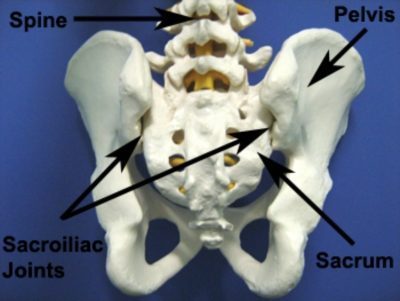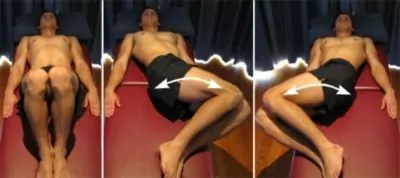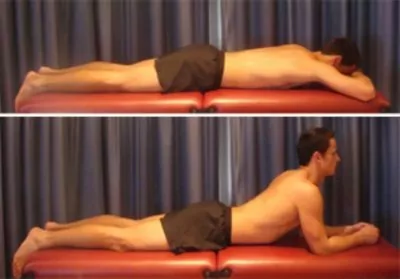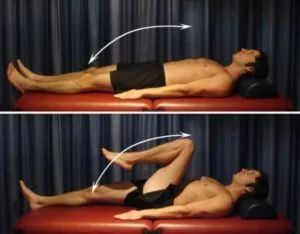Sacroiliac Joint Dysfunction
Updated:
(Also known as Sacroiliac Joint Pain, Sacroiliac Joint Sprain, SIJ Dysfunction, Sacroiliac Joint Inflammation, Sacroiliac Joint Injury, Sacroiliac Joint Disorder, Sacroiliitis, Sacroiliacitis)
What is sacroiliac joint dysfunction?
The sacroiliac joint is located in the lower part of the back and joins the tail bone (sacrum) to one of the pelvic bones (ilium). There are two sacroiliac joints – one on either side of the spine (figure 1). The sacroiliac joints act to transfer weight from the spine to the pelvis and allow a small amount of movement to occur.

During certain movements of the spine and hips, stretching or compressive forces are placed on the sacroiliac joints and surrounding ligaments. If these forces are excessive and beyond what the sacroiliac joint can withstand, injury to the sacroiliac joint may occur. This is known as sacroiliac joint dysfunction.
Causes of sacroiliac joint dysfunction
Sacroiliac joint dysfunction may occur from excessive forces being applied to the sacroiliac joint. This can be from bending, sitting, lifting, arching or twisting movements of the spine, or, from weight bearing forces associated with running or jumping. Injury to the sacroiliac joint may occur traumatically or due to repetitive or prolonged forces over time.
Signs and symptoms of sacroiliac joint dysfunction
Patients with this condition usually experience one sided low back pain around the top of the buttock with symptoms sometimes referring into the lower buttock, groin or thigh. In rare cases, pain may be felt on both sides of the lower back. Symptoms are generally exacerbated with activities that involve lower back or hip movements. Often patients will experience pain upon rolling over in bed, putting on or taking off their shoes and socks, walking up and down stairs, or with running. Tenderness is usually felt on firm palpation of the sacroiliac joint. Sacroiliac joint dysfunction may also be associated with asymmetry of the pelvis due to muscle tightness, joint stiffness, or joint laxity associated with pregnancy.
Diagnosis of sacroiliac joint dysfunction
A thorough subjective and objective examination from a physiotherapist is usually sufficient to diagnose sacroiliac joint dysfunction. Investigations such as an X-ray, MRI, bone scan or CT scan may be used to assist with diagnosis.
Treatment for sacroiliac joint dysfunction

Members Only ContentBecome a PhysioAdvisor Member to gain full access to this exclusive content. For more details see Become a Member. Already a member? Login Now
Prognosis of sacroiliac joint dysfunction
The recovery time for sacroiliac joint dysfunction may vary from patient to patient depending on compliance with physiotherapy. With ideal treatment, patients may be pain free in as little as several days, although typically this may take 2 – 3 weeks. It is important to note, however, that injured tissue takes approximately six weeks to restore the majority of its strength in ideal healing conditions. Care must therefore be taken when returning to activity during this period.
Physiotherapy for sacroiliac joint dysfunction
Physiotherapy treatment for sacroiliac joint dysfunction can hasten healing, ensure an optimal outcome and reduce the likelihood of future recurrence. Treatment may comprise:
- soft tissue massage
- mobilization
- manipulation
- electrotherapy (e.g. ultrasound)
- taping
- the use of a sacroiliac belt or lumbar brace
- the use of a lumbar roll for sitting
- correction of any leg length discrepancy
- dry needling
- muscle energy techniques
- education
- activity modification advice
- biomechanical correction
- ergonomic advice
- clinical Pilates
- hydrotherapy
- exercises to improve flexibility, strength, posture and core stability
- a gradual return to activity program
Contributing factors to the development of sacroiliac joint dysfunction
There are several factors that may contribute to the development of sacroiliac joint dysfunction. These factors need to be assessed and corrected with direction from a physiotherapist and may include:
- muscle imbalances
- leg length differences
- muscle weakness or tightness
- biomechanical abnormalities
- poor posture
- lumbar spine stiffness
- a sedentary lifestyle
- poor core stability
- inappropriate lifting technique
- being overweight
- a lifestyle involving large amounts of sitting, bending or lifting
The pelvic girdle changes associated with pregnancy may also contribute to the development of sacroiliac joint pain.
Other intervention for sacroiliac joint dysfunction
Despite appropriate physiotherapy management, a small percentage of patients with sacroiliac joint dysfunction fail to improve and may require other intervention. This may include pharmaceutical intervention, investigations such as an X-ray, bone scan, CT scan or MRI, blood tests or assessment from a specialist. A corticosteroid injection into the sacroiliac joint may sometimes be used to help alleviate symptoms. In those patients with poor foot biomechanics, review with a podiatrist may be indicated for potential orthotics. The treating physiotherapist can advise on appropriate management and can refer to the appropriate medical authority if it is warranted clinically.
Exercises for sacroiliac joint dysfunction
The following exercises are commonly prescribed to patients with this condition. You should discuss the suitability of these exercises with your physiotherapist prior to beginning them. Generally, they should be performed 3 times daily and only provided they do not cause or increase symptoms.
Your physiotherapist can advise when it is appropriate to begin the initial exercises and eventually progress to the intermediate, advanced and other exercises. As a general rule, addition of exercises or progression to more advanced exercises should take place provided there is no increase in symptoms.
Initial Exercises
Transversus Abdominus Retraining
Slowly pull your belly button in “away from your belt line” and breathe normally. Your rib cage should remain relaxed and should not elevate during this process. You should be able to feel the muscle contracting if you press deeply 2cm in from the bony process at the front of your pelvis (figure 3). Practise holding this muscle at one third of a maximal contraction for as long as possible during everyday activity (e.g. when walking etc.) provided it is pain free. Repeat 3 times daily.

Rotation in Lying
Begin this exercise lying on your back as demonstrated (figure 4). Slowly take your knees from side to side as far as possible and comfortable provided there is no increase in symptoms. Repeat 10 times.

Elbow Prop
Begin lying on your front (figure 5). Slowly move up onto your elbows provided there is no increase in symptoms. Hold this position for 2 seconds and then return to lying flat. Repeat 10 times provided the exercise is pain free.

Hip Flexion
Slowly take your knee towards your chest as far as possible and comfortable without pain (figure 6). Use your hands to gently bring your knee closer to your chest. Repeat 5 – 10 times on each leg provided there is no increase in symptoms.

Intermediate Exercises

Members Only ContentBecome a PhysioAdvisor Member to gain full access to this exclusive content. For more details see Become a Member. Already a member? Login Now
Advanced Exercises

Members Only ContentBecome a PhysioAdvisor Member to gain full access to this exclusive content. For more details see Become a Member. Already a member? Login Now
Other Exercises

Members Only ContentBecome a PhysioAdvisor Member to gain full access to this exclusive content. For more details see Become a Member. Already a member? Login Now
Rehabilitation Protocol for sacroiliac joint dysfunction

Members Only ContentBecome a PhysioAdvisor Member to gain full access to this exclusive content. For more details see Become a Member. Already a member? Login Now
 Find a Physio
Find a Physio
Find a physiotherapist in your local area to treat this condition.
 Physiotherapy products for sacroiliac joint dysfunction
Physiotherapy products for sacroiliac joint dysfunction
Some of the most commonly recommended products by physiotherapists to hasten healing and speed recovery in patients with this sacroiliac joint injuries include:
To purchase physiotherapy products for sacroiliac joint dysfunction click on one of the above links or visit the PhysioAdvisor Shop
 More Information
More Information
- View more Lower Back Stretches
- View Basic Pilates Exercises to improve your posture and core stability
- View a Return to Running Program
- View detailed information on initial injury management and the R.I.C.E. Regime
- View detailed information on when to use Ice or Heat
- View detailed information on Ergonomic Computer Setup
- View detailed information on Safe Lifting
- View detailed information on Improving Your Posture.
Become a PhysioAdvisor Member

Link to this Page
If you would like to link to this article on your website, simply copy the code below and add it to your page:
<a href="https://physioadvisor.com.au/injuries/lower-back/sacroiliac-joint-dysfunction”>Sacroiliac Joint Dysfunction – PhysioAdvisor.com</a><br/>PhysioAdvisor offers detailed physiotherapy information on Sacroiliac joint dysfunction and Sacroiliac pain including: symptoms, diagnosis, treatment, exercises and physiotherapy products.
Return to the top of Sacroiliac Joint Dysfunction.











